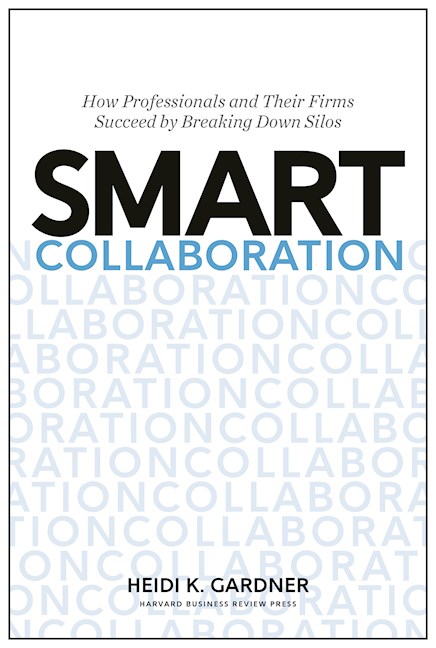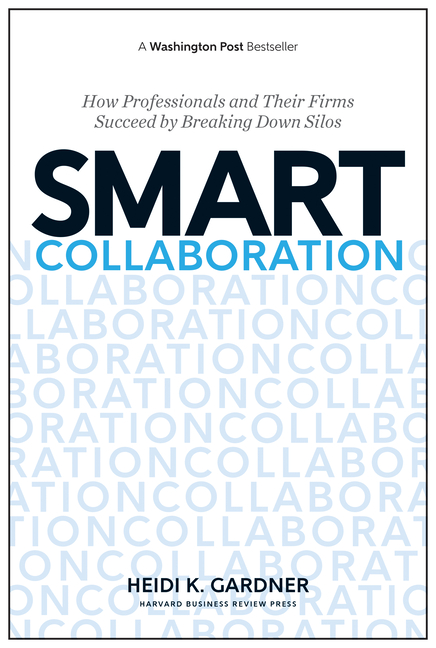Smart Collaboration: How Professionals and Their Firms Succeed by Breaking Down Silos
January 05, 2017
Heidi K. Gardner's book helps us transform our outlook and our organization from a hammer into a toolbox.

Smart Collaboration: How Professionals and Their Firms Succeed by Breaking Down Silos by Heidi K. Gardner, Harvard Business Review Press, 272 pages, $32.00, Hardcover, ISBN 9781633691100
Abraham Maslow famously said: "I suppose it is tempting, if the only tool you have is a hammer, to treat everything as if it were a nail." The same can be said of individual expertise and specialization. But, as Heidi Gardner knows, in a world of increasingly complex problems, expertise and specialization are also critically important:
Because knowledge is changing ever faster, professionals across nearly every domain must specialize to keep current.
This trend is simply a massive acceleration of a process that’s been going on for centuries.
Specialization is important, but it needs to be tied to a larger process. Even in Adam Smith’s hypothetical Pin Factory, it would make no sense for someone to endlessly draw out wire if there are not those who then straighten, cut, and put a point on it working beside them. Collaboration in a knowledge-based economy or firm will never be that straightforward or pre-determined, but it is equally inefficient and ineffective to look for all our answers—or even try to uncover the right questions—in one place or any one person as it would be to start making pins one at a time by hand again. Solving our most difficult challenges requires collaboration between individuals, organizations, and institutions.
And yet, it doesn’t always work. Collaboration has a sharp edge that cuts through the toughest problems with almost magical ease when it goes right, and a dull one that bludgeons whatever is in its path, or can slip off track entirely and cut you when it doesn’t. It can make a team either greater than the sum of its parts, or turn a room full of experts into a collective dolt.
There are both challenges and costs, benefits and barriers to collaboration. It is of critical importance to figure out how to maximize the former and minimize the latter. To do so, it is important to remember what I think is a defining line in Heidi K. Gardner’s new book, Smart Collaboration:
Smart collaboration is a means to an end, rather than an end in itself …
It takes effort and time to work with others, and if you’ve ever managed people you know how hard it can be to get people to work together. Most successful people end up where they are largely on individual effort, relying on our individual knowledge and talents. When they advance in organizations or ascend the organizational hierarchy, they tend fall back on those talents or lean on other star performers to get the job done. That not only causes burnout and makes companies over-reliant on individuals who can fall sick or leave at any time, it creates internal silos, fragments knowledge and capabilities, and makes the entire organization less responsive to the needs of its clients.
The ability to innovate, to deliver “novel, advanced solutions” that we (or our clients) cannot come up with on our own requires breaking down those silos, or at least building robust channels of communication and collaboration across them. And though the idea of collaboration is often tied to the digital economy or new communications tools, it is, again, not an end in itself but a way to address an existing problem or need:
For many clients, innovation doesn’t necessarily mean a cutting-edge, never-before-seen solution. Instead, they expect their professional advisers to innovate by taking the standard technical approach and meticulously tailoring it to the very specific needs of the client’s business.
In other words, it doesn’t matter if your product or service is technically brilliant if it’s not applicable to your clients’ needs. One early and entertaining example of this in Gardner’s book is of an auditing firm that was hired to handle a client’s International Financial Reporting Standards, but came to work with, and know, the client so well across so many silos that it became increasingly clear to a junior partner that their inventory management was not as accurate as it should be:
So rather than reverting to standard procedure—meaning, relying on the existing system—the team went into the warehouse to measure the dust on the boxes to see which inventory was older. High-tech? Hardly.
It was a quick and clever real-world way to check the digital data, and it uncovered discrepancies they could then work with them to address. Knowing the client as well as they did, they understood not only how they operated, but how they could use a novel solution to unearth and eliminate unforced errors and operate more efficiently. But it also required collaboration within the auditing firm to trust junior members to see a problem, propose an oddball solution, and make it happen.
In order to understand your clients that well, it is important to understand not only how they work, but how everyone within your organization works with them. And there is a difference between cross-selling existing products and services and smart collaboration. It is one thing to know your clients and how you interface with them so well that you can suggest other ways you can work together in mutually beneficial ways, it is another to push a separate or add-on product or service blindly to everyone.
Heidi Gardner has fascinating background in both business and law, consulting and academia. She been researching all of these issues for more than a decade, and that research shines through. But she has also took her research into a feedback loop of other experts to discuss, test, and challenge her ideas. And while working on Smart Collaboration, she developed what she called a board of contributors that would review ideas and sections of the book before publication.
[I]t turned out to be a testament to the power of surfacing and integrating the work of specialized experts. Their voices show up throughout the book, and I’m grateful for them.
She also followed one firm in depth for more than two years, tracking their transition from “a ‘franchise’ model to one based on partner-to-partner collaboration.” And she tailors sections of the book to different “constituents,” from the solo specialist who hasn’t had much reason to collaborate in the past, to seasoned collaborators, contributors, and the ringmasters that have to “get all these fractious, talented, and complementary individuals to pull together in the same direction.”
You should be forewarned that the book is quite academic, chock full of technical detail, charts and graphs. But the writing is easy to follow and fluid to the point that it actually pulls you through even the most technical points, and is as jargon free as I think is possible. And, yet, there is no pretense that the book provides all the answers. To the contrary, Gardner writes:
My prescriptions are a practical and informed point of departure for shaping a multidisciplinary solution to your complex organizational problems—which is, in fact, the same thing your clients need from you.
The book itself is a toolbox, not a hammer.
It is important to have mentors, and personal vision and motivation in your professional life, but it is just as important to have collaborators—some of whom may very well be your clients. They not only help you be more efficient and effective in your work, they provide a perspective that puts what you do in the greater whole your work exists in, giving you access to insights about your business that you wouldn’t have if you remained in your silo.
Our biggest challenges in business are no longer making pins, but in drawing out, straightening, and sharpening ideas and solutions to solve the thorny problems of an ever evolving, fast-paced world and marketplace. And, in doing so, it is still just as important to have all our individual expertise coordinated and tied together in the service of assembling those ideas and solutions to meet client needs. The rewards of doing so are financial (as Gardner writes early on, this book “provides the hard evidence for what has so far been considered a soft subject”), but they’re also interpersonal and intellectual, building strong bonds of knowledge, understanding, and camaraderie across the organization. It adds a lot to everyone’s individual toolbox within the organization, and turns the company itself into a multifaceted tool your clients can turn to every time they encounter a new problem or need.


